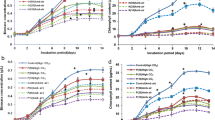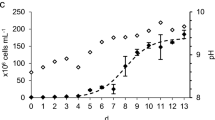Abstract
Carbon dioxide (CO2) is one of the primary greenhouse gases that contribute to climate change. Consequently, emission reduction technologies will be needed to reduce CO2 atmospheric concentration. Microalgae may have an important role in this context. They are photosynthetic microorganisms that are able to fix atmospheric CO2 using solar energy with efficiency ten times higher than terrestrial plants. The objectives of this study were: (i) to analyse the effect of light supply on the growth of Chlorella vulgaris and Pseudokirchneriella subcapitata; (ii) to assess the atmospheric CO2 capture by these microalgae; and (iii) to determine the parameters of the Monod model that describe the influence of irradiance on the growth of the selected microalgae. Both microalgae presented higher growth rates with high irradiance values and discontinuous light supply. The continuous supply of light at the highest irradiance value was not beneficial for C. vulgaris due to photooxidation. Additionally, C. vulgaris achieved the highest CO2 fixation rate with the value of 0.305 g-CO2 L−1 d−1. The parameters of the Monod model demonstrated that C. vulgaris can achieve higher specific growth rates (and higher CO2 fixation rates) if cultivated under higher irradiances than the studied values. The presented results showed that microalgal culture is a promising strategy for CO2 capture from atmosphere.

Similar content being viewed by others
References
Allen MR, Frame DJ, Huntingford C, Jones CD, Lowe JA, Meinshausen M, Meinshausen N (2009) Warming caused by cumulative carbon emissions towards the trillionth tonne. Nature 458(7242):1163–1166
Bailey JE, Ollis DF (eds) (1986) Biochemical engineering fundamentals, 2nd edn. McGraw-Hill, Singapore
Carvalho AP, Silva SO, Baptista JM, Malcata FX (2011) Light requirements in microalgal photobioreactors: an overview of biophotonic aspects. Appl Microbiol Biot 89(5):1275–1288
Chanakya HN, Mahapatra DM, Sarada R, Abitha R (2013) Algal biofuel production and mitigation potential in India. Mitig Adapt Strat Gl 18(1):113–136
Chapman RL (2013) Algae: the world’s most important “plants”-an introduction. Mitig Adapt Strat Gl 18(1):5–12
Chisti Y (2007) Biodiesel from microalgae. Biotechnol Adv 25(3):294–306
Chisti Y (2008) Biodiesel from microalgae beats bioethanol. Trends Biotechnol 26(3):126–131
Dovi VG, Friedler F, Huisingh D, Klemes JJ (2009) Cleaner energy for sustainable future. J Clean Prod 17(10):889–895
DuPont A (2013) Best practices for the sustainable production of algae-based biofuel in China. Mitig Adapt Strat Gl 18(1):97–111
Fergola P, Cerasuolo M, Pollio A, Pinto G, DellaGreca M (2007) Allelopathy and competition between Chorella vulgaris and Pseudokirchneriella subcapitata: experiments and mathematical model. Ecol Model 208(2–4):205–214
Gonçalves AL, Pires JCM, Simões M (2013) Biodiesel from microalgal oil extraction. In: Lichtfouse E, Schwarzbauer J, Robert D (eds) Environmental chemistry for a sustainable world, vol 3. Accepted for Publication. Springer
Jacob-Lopes E, Scoparo CHG, Lacerda LMCF, Franco TT (2009) Effect of light cycles (night/day) on CO2 fixation and biomass production by microalgae in photobioreactors. Chem Eng Process 48(1):306–310
Jin HF, Lim BR, Lee K (2006) Influence of nitrate feeding on carbon dioxide fixation by microalgae. J Environ Sci Heal A 41(12):2813–2824
Keith DW (2009) Why capture CO2 from the atmosphere? Science 325(5948):1654–1655
Keith DW, Ha-Duong M, Stolaroff JK (2006) Climate strategy with CO2 capture from the air. Clim Chang 74(1–3):17–45
Kwon B, Park N, Cho J (2005) Effect of algae on fouling and efficiency of UF membranes. Desalination 179(1–3):203–214
Lemoine DM, Fuss S, Szolgayova J, Obersteiner M, Kammen DM (2012) The influence of negative emission technologies and technology policies on the optimal climate mitigation portfolio. Clim Chang 113:141–162
McLaren D (2011) Negatonnes—an initial assessment of the potential for negative emission techniques to contribute safely and fairly to meeting carbon budgets in the 21st Century. http://www.foe.co.uk/resource/reports/negatonnes.pdf. Cited December 2012
McLaren D (2012) A comparative global assessment of potential negative emissions technologies. Process Saf Environ 90(6):489–500
Merchuk JC, Ronen M, Giris S, Arad S (1998) Light/dark cycles in the growth of the red microalga Porphyridium Sp. Biotechnol Bioeng 59(6):705–713
Molina E, Fernandez J, Acien FG, Chisti Y (2001) Tubular photobioreactor design for algal cultures. J Biotechnol 92(2):113–131
Moss RH, Edmonds JA, Hibbard KA, Manning MR, Rose SK, van Vuuren DP, Carter TR, Emori S, Kainuma M, Kram T, Meehl GA, Mitchell JFB, Nakicenovic N, Riahi K, Smith SJ, Stouffer RJ, Thomson AM, Weyant JP, Wilbanks TJ (2010) The next generation of scenarios for climate change research and assessment. Nature 463(7282):747–756
Murakami M, Ikenouchi M (1997) The biological CO2 fixation and utilization project by RITE.2. Screening and breeding of microalgae with high capability in fixing CO2. Energ Convers Manag 38:493–497
Obersteiner M, Azar C, Kauppi P, Mollersten K, Moreira J, Nilsson S, Read P, Riahi K, Schlamadinger B, Yamagata Y, Yan J, van Ypersele JP (2001) Managing climate risk. Science 294(5543):786–787
OECD (2011) Freshwater alga and cyanobacteria, growth inhibition test, test guideline 201. Cited December 2012
Pielke RA (2009) An idealized assessment of the economics of air capture of carbon dioxide in mitigation policy. Environ Sci Policy 12(3):216–225
Pires JCM, Martins FG, Alvim-Ferraz MCM, Simoes M (2011) Recent developments on carbon capture and storage: an overview. Chem Eng Res Des 89(9A):1446–1460
Pires JCM, Alvim-Ferraz MCM, Martins FG, Simões M (2012) Carbon dioxide capture from flue gases using microalgae: engineering aspects and biorefinery concept. Renew Sust Energ Rev 16:3043–3053
Rockstrom J, Steffen W, Noone K, Persson A, Chapin FS, Lambin EF, Lenton TM, Scheffer M, Folke C, Schellnhuber HJ, Nykvist B, de Wit CA, Hughes T, van der Leeuw S, Rodhe H, Sorlin S, Snyder PK, Costanza R, Svedin U, Falkenmark M, Karlberg L, Corell RW, Fabry VJ, Hansen J, Walker B, Liverman D, Richardson K, Crutzen P, Foley JA (2009) A safe operating space for humanity. Nature 461(7263):472–475
Shepherd J, Caldiera K, Cox P, Haigh J, Keith D, Launder B, Mace G, MacKerron G, Pyle J, Rayner S, Redgwell C, Watson A (2009) Geoengineering the climate: science, governance and uncertainty. Cited December 2012
Sing SF, Isdepsky A, Borowitzka MA, Moheimani NR (2013) Production of biofuels from microalgae. Mitig Adapt Strat Gl 18(1):47–72
Singh UB, Ahluwalia AS (2013) Microalgae: a promising tool for carbon sequestration. Mitig Adapt Strat Gl 18(1):73–95
Tang DH, Han W, Li PL, Miao XL, Zhong JJ (2011) CO2 biofixation and fatty acid composition of Scenedesmus obliquus and Chlorella pyrenoidosa in response to different CO2 levels. Bioresour Technol 102(3):3071–3076
Taştan BE, Duygu E, İlbaş M, Dönmez G (2013) Utilization of LPG and gasoline engine exhaust emissions by microalgae. J Hazard Mater 246–247:173–180
Wang B, Li YQ, Wu N, Lan CQ (2008) CO2 bio-mitigation using microalgae. Appl Microbiol Biot 79(5):707–718
Yeh KL, Chang JS (2011) Nitrogen starvation strategies and photobioreactor design for enhancing lipid production of a newly isolated microalga Chlorella vulgaris ESP-31: implications for biofuels. Biotechnol J 6(11):1358–1366
Acknowledgments
A.L. Gonçalves and J.C.M. Pires are grateful to Foundation for Science and Technology (FCT), POPH-QREN and FSE for their fellowships SFRH/BD/88799/2012 and SFRH/BPD/66721/2009, respectively.
Author information
Authors and Affiliations
Corresponding author
Rights and permissions
About this article
Cite this article
Pires, J.C.M., Gonçalves, A.L., Martins, F.G. et al. Effect of light supply on CO2 capture from atmosphere by Chlorella vulgaris and Pseudokirchneriella subcapitata . Mitig Adapt Strateg Glob Change 19, 1109–1117 (2014). https://doi.org/10.1007/s11027-013-9463-1
Received:
Accepted:
Published:
Issue Date:
DOI: https://doi.org/10.1007/s11027-013-9463-1




